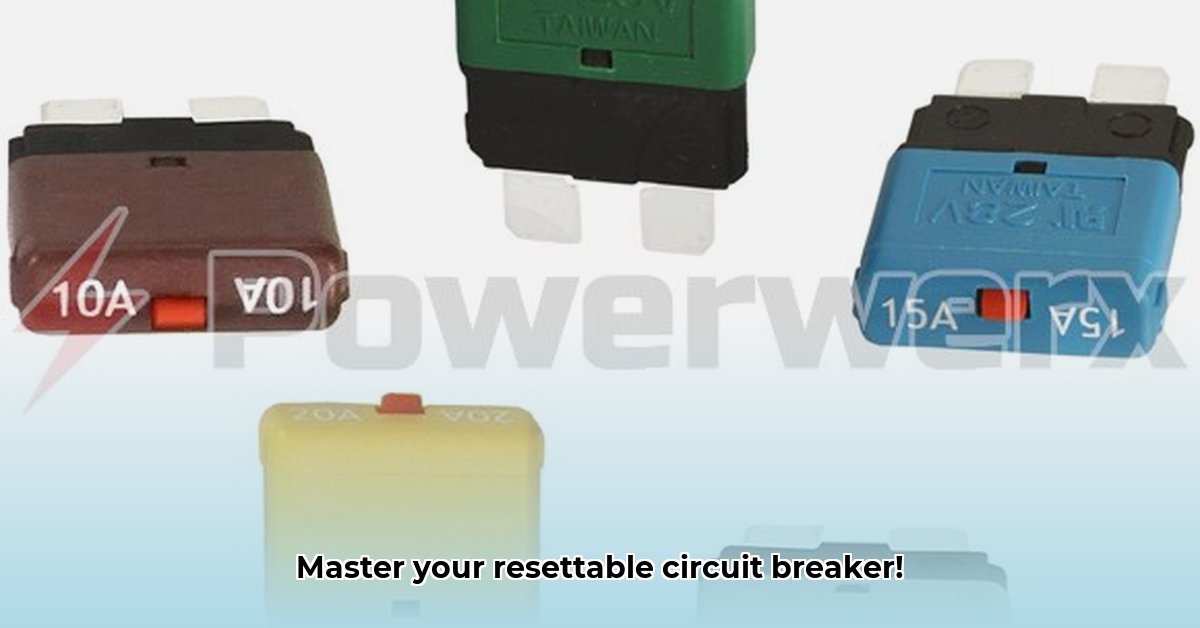“`markdown
Resettable Circuit Breaker Guide: Safety & Troubleshooting
Thinking about safer home electricity? Resettable circuit breakers (RCBs) might be the answer. This guide breaks down everything you need to know about them – from understanding how they work and why they’re better than old-fashioned fuses, to safely installing them and fixing common problems. We’ll cover choosing the right breaker for your needs, step-by-step instructions, and even troubleshooting tips, helping you keep your home’s electricity safe and reliable. Whether you’re a homeowner doing some DIY, an electrician looking for best practices, or even a manufacturer, this guide has you covered. For more on breaker boxes vs. fuse boxes, see this helpful comparison.
Understanding Resettable Circuit Breakers: Enhancing Home Electrical Safety
Let’s talk about resettable circuit breakers (RCBs). These devices are essential for your home’s electrical system, protecting you from electrical mishaps. Think of them as safety switches that automatically shut off power when things get dangerous, preventing potential fires and damage to your appliances. Unlike fuses, which need replacing every time they trip, RCBs are reusable – just reset them once the problem’s fixed. They play a critical role in electrical safety measures. Understanding their function and proper usage significantly reduces the risk of electrical fires and equipment damage.
How Resettable Circuit Breakers Work: The Inside Scoop
RCBs constantly monitor the electrical flow in your circuits, ensuring it remains within safe parameters. If the current gets too high – like when you plug in too many power-hungry devices at once – a thermal or magnetic mechanism within the RCB trips the breaker, cutting off the power. This prevents overheating, which could lead to a fire. Once you’ve identified and resolved the cause of the overload, you can simply reset the breaker and power’s back on. They use a bimetal strip (responding to heat) and a magnetic coil (responding to current surges). Some RCBs can be manually reset even when a fault persists, potentially endangering you and your property. Trip-free mechanisms prevent this, ensuring the breaker cannot be reset until the fault is resolved.
RCBs: Weighing the Pros and Cons of Electrical Safety Devices
Resettable circuit breakers offer several benefits, but it’s good to know their limitations too. Let’s break it down:
Pros:
- Reusable: No more hunting for replacement fuses – simply reset the breaker. This saves you both time and money.
- Cost-Effective: The long-term savings are significant.
- Convenient: Resetting is quick and easy (with the proper safety precautions, of course!).
- Enhanced Safety: RCBs protect your home from electrical fires.
- Sensitivity: Modern RCBs are designed to minimize nuisance tripping, offering a good balance between sensitivity and reliability.
- Ease of Identification: Tripped breakers are easily identifiable, simplifying troubleshooting.
Cons:
- Not a silver bullet: RCBs may not protect against every type of electrical fault. Some ground faults, for example, might require a more specialized solution like a GFCI (Ground Fault Circuit Interrupter) breaker.
- Requires manual reset: You need to manually reset the breaker each time. This may be inconvenient in hard-to-reach locations.
- Potential for Nuisance Tripping: Although less common with modern breakers, RCBs can sometimes trip unnecessarily, especially during minor power surges or voltage fluctuations.
Picking the Right RCB: A Smart Choice
Choosing the right RCB is crucial for safety and effectiveness. The amperage rating is key. This rating specifies how much current the breaker can handle before tripping. Getting this wrong could lead to overloads, fires, or even damage to your appliances. A qualified electrician can help you determine the correct amperage for each circuit in your home. Also, consider the interrupting rating, which indicates the maximum short-circuit current the breaker can safely interrupt. For added safety, consider trip-free RCBs. These breakers prevent accidental resetting while a fault is still present, preventing a dangerous situation.
Installing and Using Your RCB Safely: A Step-by-Step Guide
While installing some RCBs is relatively simple, it’s crucial to prioritize safety. If you’re unsure about any aspect of electrical work, it’s always best to call an experienced electrician. How do you reset an RCB? Ensure power is off at the breaker/electrical panel, then visually check the circuit’s load to ensure the fault has been addressed.
1. Installation: Always follow the manufacturer’s instructions carefully. Working with electricity is not a game. Improper installation can lead to serious consequences. A licensed electrician should perform the installation to ensure compliance with local electrical codes and regulations.
2. Resetting the Breaker: Before you even touch the breaker, make absolutely sure the power is OFF. Then, firmly push the breaker back to the “ON” position. If it doesn’t stay on, resist the urge to keep trying. Something’s wrong. Call an electrician. Consider the breaker’s location for easy access and visibility.
3. Recognizing Overloads: Frequent tripping usually signifies an overloaded circuit. This happens when you have too many devices drawing power on the same circuit. Unplug unnecessary items or distribute the load across multiple circuits. Also, the RCB’s rating must match or slightly exceed this amperage. Select a breaker with a rating appropriate for the load. Calculate the total current draw of all devices on the circuit to prevent recurring overloads.
4. Regular Check-ups: Periodically inspect your RCBs and wiring for any signs of damage, such as loose wires, damaged insulation, or burn marks. Catching problems early is significantly better than dealing with a disaster. This helps avoid electrical hazards. Look for discoloration or unusual sounds. Ensure the surrounding area is free from moisture, dust, and debris to maintain optimal breaker performance.
5. When to Call for Help: Don’t hesitate to contact a qualified electrician if you experience persistent problems, frequent tripping, unusual smells (like burning plastic), or any sparking around your electrical panel. These are strong indicators of an underlying electrical issue that requires professional attention. The RCB’s rating must match or slightly exceed this amperage. Document any recurring issues or unusual observations to assist the electrician in diagnosing the problem.
Troubleshooting: Solving Common RCB Issues and Circuit Breaker Problems
Most issues with resettable circuit breakers stem from simple overloads. However, some problems require professional help.
- Frequent tripping: This often indicates an overloaded circuit. Try unplugging some appliances or spreading the load across multiple circuits. If the problem continues, there might be a more serious issue, such as a short circuit or ground fault.
- Breaker won’t reset: This is a serious red flag. It suggests a fault somewhere in the wiring. Do not attempt to fix this yourself. Call a qualified electrician immediately. This could indicate a short circuit, ground fault, or a malfunctioning breaker.
- Breaker feels hot to the touch: This is a sign of an overloaded circuit or a loose connection. Turn off the breaker immediately and call an electrician.
- Burning smell: Any burning smell coming from the electrical panel is a serious safety hazard. Evacuate the area and call the fire department immediately.
The Bottom Line: Safety First with Your Electrical Panel Breaker
RCBs are fantastic safety devices, but they’re not a substitute for safe electrical practices. This guide gives you some foundational knowledge, but remember that electricity is powerful and dangerous. If you’re ever unsure about anything electrical, err on the side of caution and contact a qualified electrician. Your safety is worth it. By addressing safety concerns, you can avoid expensive repairs and potential hazards down the line, ensuring a safer, more efficient home. Always prioritize safety and adhere to electrical codes and regulations.
How to Choose the Right Resettable Circuit Breaker for My Home: A Detailed Guide to Circuit Protection
Key Takeaways:
- Understanding the different types of resettable circuit breakers (RCBs) and their applications is crucial for home safety, ensuring optimal circuit protection.
- Proper amperage rating selection, matching the breaker to the wire gauge, prevents overheating and potential fires, safeguarding your electrical system safety.
- Safe installation and regular inspection are vital to ensure RCB functionality and prevent electrical hazards, promoting safe electrical practices.
- Knowing when to reset the breaker yourself versus calling a qualified electrician is essential for maintaining electrical safety standards.
- Identifying and addressing the root causes of frequent tripping safeguards your home’s electrical system, preventing electrical hazards.
- Considering specialized breakers like GFCI and AFCI increases safety in moisture-prone areas and protects against arc faults, enhancing electrical safety measures.
What are Resettable Circuit Breakers?
Resettable circuit breakers (RCBs) are safety devices preventing electrical overloads and short circuits. Unlike traditional fuses, which need replacing after a trip, RCBs reset themselves once the fault is cleared. They’re designed to protect your wiring and appliances from damage. But, are they right for your home? For specific areas like bathrooms or kitchens, consider breakers with built-in ground fault circuit interrupter (GFCI) or arc fault circuit interrupter (AFCI) protection. These add an extra layer of safety against electrical shocks and arc faults, respectively. GFCI breakers are essential in areas with water exposure, while AFCI breakers protect against dangerous arc faults that can cause electrical fires. Why should you consider these? Increased safety is worth the extra cost.
- Glass Backsplash: Ideas For a Stylish Kitchen Update - December 2, 2025
- Glass On Tile: A Stylish Kitchen Backsplash Option - December 1, 2025
- Glass Tiles for Kitchen: Style and Durability Tips - November 30, 2025










